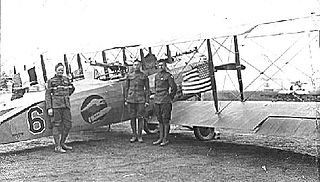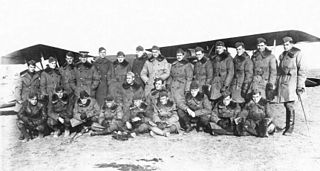
The 94th Aero Squadron was a United States Army Air Service fighter squadron that fought on the Western Front during World War I. The squadron was assigned as a Day Pursuit (Fighter) Squadron as part of the 1st Pursuit Group, First United States Army. Its mission was to engage and clear enemy aircraft from the skies and provide escort to reconnaissance and bombardment squadrons over enemy territory. It also attacked enemy observation balloons and performed close air support and tactical bombing attacks of enemy forces along the front lines.

The 95th Aero Squadron was an Air Service, United States Army unit that fought on the Western Front during World War I. It was the first American pursuit (fighter) squadron to fly in combat on the Western Front, beginning on 8 March 1918.

The 12th Aero Squadron was a United States Army Air Service unit that fought on the Western Front during World War I.

The 13th Aero Squadron was a United States Army Air Service unit that fought on the Western Front during World War I.

Toul-Croix De Metz Airfield is a former military airfield which is located approximately one mile (1.6 km) northeast of Toul ; 160 miles (260 km) east of Paris.

The 25th Aero Squadron was a United States Army Air Service unit that fought on the Western Front during World War I.

The 49th Aero Squadron was a United States Army Air Service unit that fought on the Western Front during World War I.

The 103rd Aero Squadron was an aviation pursuit squadron of the U.S. Air Service that served in combat in France during World War I. Its original complement included pilots from the disbanded Lafayette Escadrille and Lafayette Flying Corps. One of those pilots, Paul F. Baer, became the first ace of an American unit in World War I.

The 28th Aero Squadron was a United States Army Air Service unit that fought on the Western Front during World War I.

The 93d Aero Squadron was an Air Service, United States Army unit that fought on the Western Front during World War I.

The 139th Aero Squadron was a United States Army Air Service unit that fought on the Western Front during World War I.

The 147th Aero Squadron was a United States Army Air Service unit that fought on the Western Front during World War I.

The 22nd Aero Squadron was a United States Army Air Service unit that fought on the Western Front during World War I.

The IV Corps Observation Group was an Air Service, United States Army unit that fought on the Western Front during World War I. It was demobilized on 12 May 1919. There is no modern United States Air Force unit that shares its lineage and history.

The Organization of the Air Service of the American Expeditionary Force on 11 November 1918, represents its maximum strength in World War I. Units of the Air Service are listed as assigned to the order of battle for that date, which was that of the Armistice with Germany. The first air unit arrived in France in September 1917, while the final air unit reaching the front did so on 9 November 1918. Unit operations began in April 1918. At the armistice, 57,508 officers and men served in the Air Service of the AEF, 24,512 in the Zone of Advance, and 32,996 in the Services of Supply. Of its 6,861 officers, 4,088 were on flying status and 219 were qualified observation balloon aviators. 1,724 of those on flying status and approximately 100 of the balloonists served in combat units.

Vaucouleurs Aerodrome, was a temporary World War I airfield in France. It was located 2.1 miles (3.4 km) West-Northwest of Vaucouleurs, in the Meuse department of France, located approximately 300 km (190 mi) from Paris.
Belrain Aerodrome was a temporary World War I airfield in France, initially used by French units, and later by squadrons of the Air Service, United States Army. It was located 0.7 miles (1.1 km) south of Belrain, approximately 35 miles (56 km) west-north-west of Toul. in the Meuse department in the Lorraine region in northeastern France.

The 4th Pursuit Group was a United States Army Air Service unit that fought on the Western Front during World War I as part of the Air Service, Second United States Army. It was demobilized in France on 15 April 1919. There is no modern United States Air Force unit that shares its lineage and history.

The 168th Aero Squadron was a United States Army Air Service unit that fought on the Western Front during World War I.

The 278th Aero Squadron was a United States Army Air Service unit that fought on the Western Front during World War I.




















